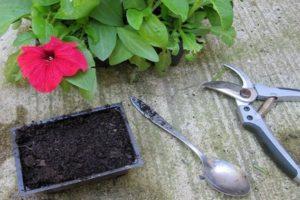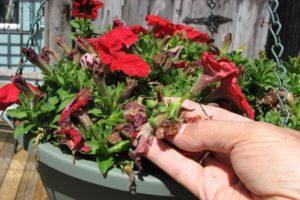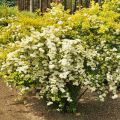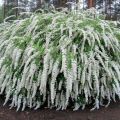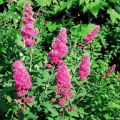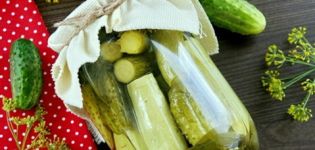Description of varieties of birch spirea, planting and care in the open field
Spirea bushes are planted on their plots by gardeners and used by landscape designers as urban decoration. Breeders have bred about 90 plant species with different flowering periods. The peculiarity of birch spirea is in the blooming of inflorescences in summer, at a time when most of the other species have already faded. It attracts attention with the beauty of not only the buds, but also the leaves that change their color during the season.
Description and characteristics
Spiraea birch-leaved - undersized deciduous shrub. Its height varies from 50 to 80 centimeters, the crown spreads the same distance. The plant got its name for the leaf plates, which have the same notches as birch leaves. They are oval in shape, with a wedge-shaped base, green in color, with protruding veins.
Spirea bloom begins at 3-4 years of age. Inflorescences, consisting of 20-100 flowers, are cream, white, pink in color. By autumn, the green leaves turn yellow-red. The plant is frost-resistant, withstands temperatures down to -35 ° C.
Varietal variety
The following varieties of birch spirea are most popular among gardeners and landscape designers:
- Thor. The height of the bushes reaches 70-100 centimeters. The leaves are dark green in color, in autumn they acquire a yellow color. Tor's light cream blossoms bloom in late June and early July.
- Thor Gold. The beauty of this variety lies in the light green leaves in summer and purple-violet in autumn. The inflorescences of the Tor Gold variety are white, blooming in mid-summer.
- Iceland. Compared to other varieties, Iceland is taller. Its height can reach 1.5 meters. The crown spreads up to 1.8 meters. Spirea blooms from mid-June to early August.
- Pink Sparkler. Description and characteristics: the bush is compact, its height reaches 60 centimeters. The peculiarity of the variety is in the inflorescences of a pink palette. The plant blooms until early August.
Note! If you cut off the brown buds in time, in the fall, a second wave of flowering will begin in the birch spirea.
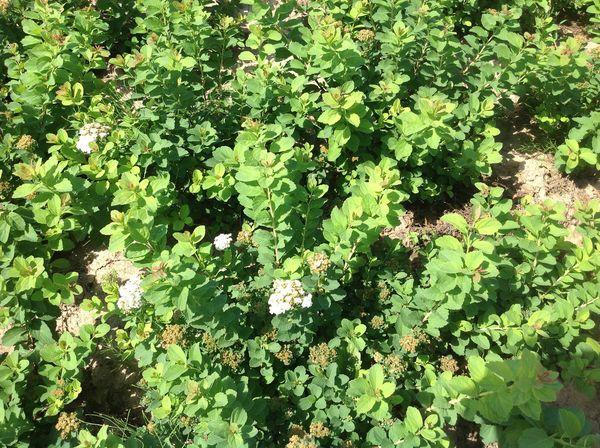
The subtleties of growing a culture
In order for the birch spirea to grow decorative, bloom profusely, you need to plant it correctly. There should be a fairly large distance between the bushes, since they have a spreading crown: between tall varieties - about 1 meter, between low-growing ones - up to 80 centimeters. If the plants are planted as a hedge, the distance between them is maintained in the range of 30-50 centimeters.
Landing dates
It is possible to plant birch spirea in open ground in early spring and autumn. When planting in spring, there should be no signs of vegetation on the bushes. In the fall, spirea is planted from mid-October to mid-November. At the same time, overgrown bushes are planted. Bushes grown in containers can be planted at any time, but shade them with burlap on a hot afternoon.
How and where to plant?
Spirea birch leaves prefers well-lit places with breathable soil. The brightness of the leaves depends on the level of illumination. Plants are planted in cloudy weather. The substrate is prepared from the following components:
- leafy and sod land;
- heavy soil is lightened by peat and sand;
- clay is added to the sandy soil.

The root system is inspected before planting: if there are broken or rotten roots on it, they are removed with a sharp knife. Too long shoots are shortened by a third. Planting birch spirea is performed as follows:
- A hole is dug in volume 2 times larger than the root system of the plant. The planting hole should settle a little, so they begin to prepare it 2 weeks before planting the spirea.
- Expanded clay, broken shards, small stones are laid at the bottom. The drainage layer should be at least 10 centimeters.
- The prepared substrate is poured from above, a bush is placed in the center of the pit. Then the soil is poured out - so that the root collar is level with the ground.
- The substrate is slightly compacted, watered.
So that moisture is retained in the soil and weeds do not grow, it must be sprinkled with mulch.
The nuances of plant care
As with every plant, birch spirea requires at least minimal care, including watering, top dressing, and pruning to maintain its decorative appearance.
Watering
Recently planted bushes are especially in need of watering: the moist earth will allow the plants to grow stronger and grow faster. In the future, watering is done as needed. It is especially necessary to moisten the earth in dry summers. At least 15 liters of water is poured under one bush. After watering, the soil is loosened to prevent crusting.
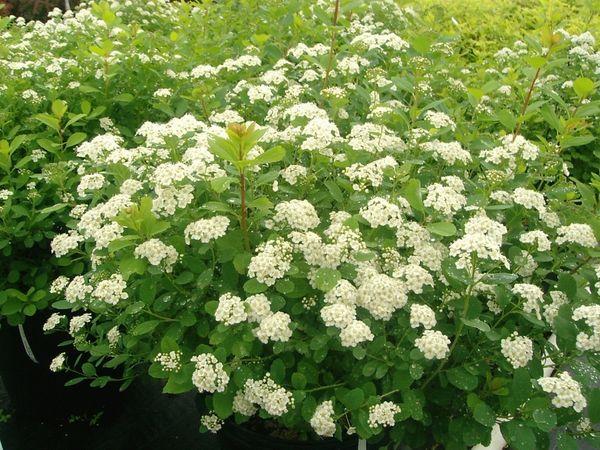
Top dressing
They begin to feed birch spirea the next season after planting. For this, a composition is prepared from the following components:
- 200 grams of mullein;
- 10 liters of water;
- 5 grams of superphosphate.
The first feeding is done after spring pruning, the next one before flowering. For secondary fertilization, a potassium-phosphorus composition is used. You can use ready-made dressings for decorative flowering plants. Rotting mulch also serves as a fertilizer for birch spirea.
Important! At the end of summer, the bushes are not fed with nitrogen: shoots that do not have time to ripen by winter can begin to actively grow from it.
Pruning
The pruning procedure begins before the beginning of the growing season of the plants. For this, young shoots are collected in a bunch and pruned to the outer buds. Small and weak branches are removed completely. After 4-5 years, all shoots are shortened to a height of 30 centimeters. At the same time, the buds will wake up, which will begin to grow actively, making the bush more lush.
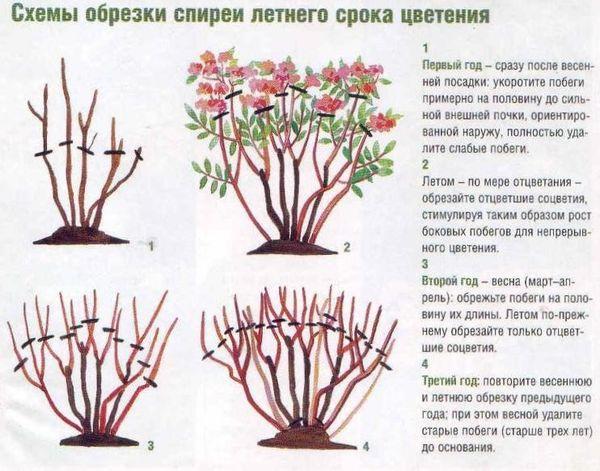
When the inflorescences of the spirea turn brown, they must be removed. Pruning them contributes to the decorative effect of the bushes, and also does not allow plants to waste energy on the formation of fruits unnecessary for gardeners. To rejuvenate the plantings, all shoots are completely cut out after 10-12 years. If you do not make constant pruning, then the spirea bushes will turn into untidy thickets.
Possible diseases and pests
Spiraea birch leaves rarely get sick, but if too much precipitation falls during the season, it can be struck by fungal diseases. If rot is found on the plant, then it must be treated with a fungicide.To prevent diseases in early spring, the bushes are sprayed with Bordeaux liquid.
Bushes can be overcome by insects such as aphids, rosaceous miner, spider mite, leafworm. They are able to harm spirea in a short time, reducing its decorative effect. It is possible to determine that the bushes have been attacked by pests by seeing a cobweb on them, premature yellowing and leaf fall. Spraying with insecticides will help to save the plantings.

Breeding methods
Birch spirea can be propagated in several ways: by cuttings, layering, dividing the bush.
Cuttings
Cutting is carried out as follows:
- In autumn, young lignified shoots are cut off, the growth direction of which is strictly upward.
- All leaves are removed, except for the top 5, which are cut in half.
- Cuttings are dipped in a growth stimulator solution for 10 hours.
- At a slight angle, the shoots are planted in containers in wet sand.
Containers with plantings in the fall are buried in the soil, take cover. In the spring, each stalk is planted separately in the ground, in the fall, the grown seedlings are transferred to a prepared permanent place.

Layers
To spread the spirea with layering, it is necessary to pin the lower shoots to the ground in spring, water, sprinkle with soil. Throughout the season, the places where cuttings come into contact with the ground are kept moist. Layers are covered for the winter. In the spring, they are separated from the mother plant and planted in a separate place.
Dividing the bush
Reproduction of birch spirea by dividing the bush is carried out in the fall. For this, plantings are selected that are no more than 3-4 years old, otherwise it will be difficult to dig out a powerful root system. The bush is divided in such a way that each section has a strong root and trunk. The plantings are watered and mulched to protect them from freezing.
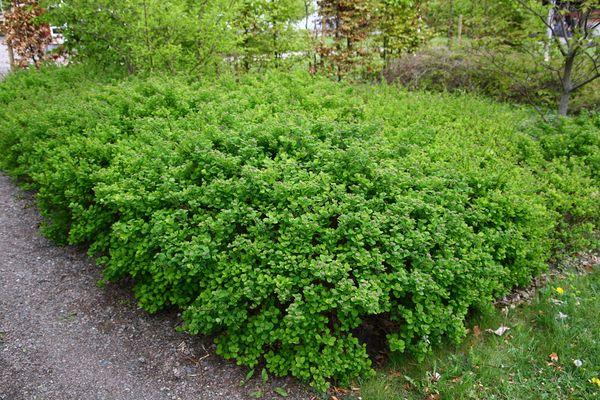
Advice! Young plants planted in autumn should be mulched and, with the onset of frost, covered.
Application in landscape design
Birch spirea is used both in garden plots and in parks, city flower beds, mixborders, and alpine slides. In addition, hedges and high curbs are built from it. Spirea is decorative not only during the flowering period, but also after it. The leaves, which are green at first, acquire a crimson hue over time. For these qualities, both gardeners and landscape designers love her.
